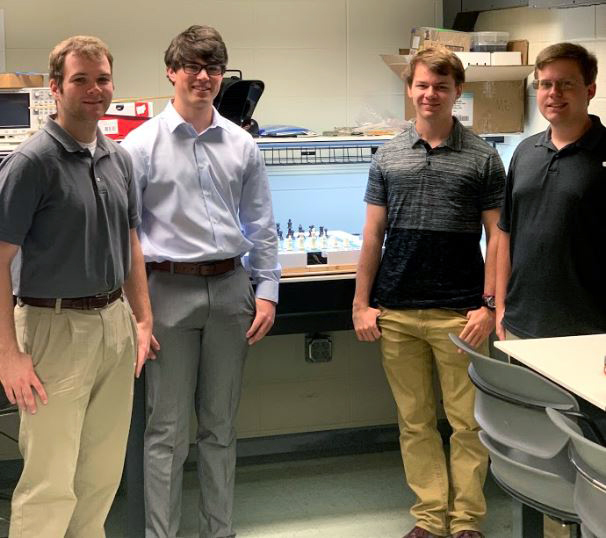Senior Design Spotlight - Team Knights of the Square Table

An important part of senior year for Purdue ECE students is senior design. Teams incorporate all of their previous coursework to take on a challenging engineering project. Students decide on a project and then design and test a system, component, or process to meet the goals they have set.
In Spring 2019, Team Knights of the Square Table designed and built the Rook-eChess Board. Students Adam Behnke, Mitchell Keeney, Zachary Neumann, and Timothy Pansino featured Tom Kerrigan’s Simple Chess Program (TSCP) as the AI in this beginner’s chessboard aimed at teaching people who are high school aged or above how to play chess. The electronic chess board can be played in one or two player mode and detects piece locations using RFID. Using this information, it illuminates the tiles (with RGB LEDs) with useful information, such as movement possibilities, setup information, and AI move decisions. This is intended to help a beginner learn with all of the advantages of chess software while on the traditional physical board.
The design detects pieces uniquely using NFC tags hidden under the felt on each piece’s base, and each square contains an NFC antenna and RGB LED. To reduce cost, one NFC reader is used per eight squares using analog switching to read from multiple antennas. The entire project is controlled by an STM32F411 microcontroller programmed entirely in C.

Pansino says the team was unfamiliar with NFC at the start of the project.
“We realized early on that there was going to be a lot of research that needed done not only on antenna design and analog switching but also how to communicate with an NFC reader IC,” he says. “It took much longer than expected to get a working prototype of a single antenna, and we couldn’t move forward with creating a PCB for the antennas until that was finished. Luckily our early testing paid off and our single antenna scaled up to an entire board fairly seamlessly.”
Pansino says the team learned a lot of valuable lessons about the design process and prototyping from building the Rook-eChess Board.
“We especially saw the need for multiple revisions to create a great product,” he says. “This project was a great opportunity to not only practice some valuable skills, but also to learn to go out and research a skill you need that no one on the team currently possesses.”
